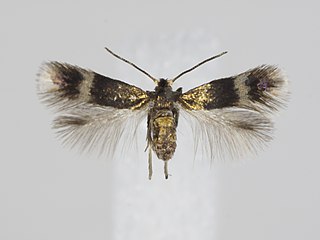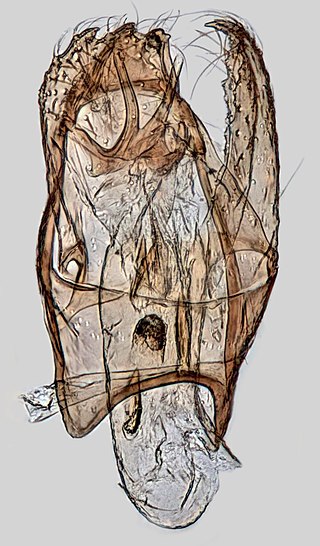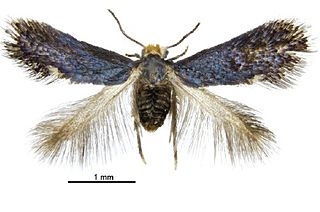Stigmella oxyacanthella is a moth of the family Nepticulidae, found in Europe and North America. The larvae are leaf miners feeding inside the leaves of trees and shrubs, such as hawthorn, apple and pear.

Stigmella tityrella is a species of moth in the family Nepticulidae. It is found in all of Europe west of Russia.

Stigmella lapponica is a moth of the family Nepticulidae found in Asia, Europe and North America. It was first described by the German entomologist, Maximilian Ferdinand Wocke in 1862. The larvae mine the leaves of birch.
Stigmella sorbi is a moth of the family Nepticulidae, described by Henry Tibbats Stainton in 1861. It is found in most of Europe, east to the eastern part of the Palearctic realm.

Stigmella crataegella is a moth of the family Nepticulidae found in Europe. It was described by the Austrian entomologist Josef Wilhelm Klimesch in 1936. The larvae mine the leaves of hawthorns.

Stigmella dryadella is a moth of the family Nepticulidae. It is found from Fennoscandia and northern Russia to the Pyrenees and Italy, and from Ireland to Romania.

Stigmella luteella is a moth of the family Nepticulidae. It is found in all of Europe, except the Iberian Peninsula and the Balkan Peninsula.

Stigmella magdalenae is a moth of the family Nepticulidae. It is found from Scandinavia and Finland to the Pyrenees, Italy and Bulgaria, and from Ireland to central Russia and Ukraine.

Stigmella nylandriella is a moth of the family Nepticulidae. It is found in all of Europe, east to Russia, where it has been recorded from Bryansk, Murmansk, Karelia, Leningrad and Voronezh.

Stigmella obliquella is a moth of the family Nepticulidae which feeds on willow and can be found in Asia and Europe. It was first described by Hermann von Heinemann in 1862.

Ectoedemia heringella is a moth of the family Nepticulidae. It is found in the Mediterranean Region, from southern France, Corsica, Sardinia, and Italy to Cyprus. It was first recorded from Great Britain in 2002.

Enteucha acetosae, the pygmy sorrel moth, is a moth of the family Nepticulidae found in Europe. It is one of the smallest moths in the world with some having a wingspan of only 3mm. The larvae mine the leaves of docks, leaving bright red tissue around the mines.
Trifurcula ridiculosa is a moth of the family Nepticulidae. It is only known from the Canary Islands: Tenerife, La Palma, La Gomera, El Hierro and Madeira, including Porto Santo island.

Trifurcula cryptella is a moth of the family Nepticulidae. It is widespread throughout Europe
Trifurcula eurema is a moth of the family Nepticulidae. It is widespread throughout Europe, northwards to southern Norway and Sweden, Poland and the Baltic Region. It is also found in the Mediterranean region, including the larger Mediterranean islands, east to Bulgaria, Asiatic Turkey and Ukraine.
Trifurcula manygoza is a moth of the family Nepticulidae. It is only known to be from Croatia and north-western Greece. But is probably also present in other Balkan countries.

Trifurcula immundella, the broom pygmy moth, is a moth of the family Nepticulidae. It is found in western Europe, wherever the host plant occurs.

Nematopogon pilella is a moth of the Adelidae family. It is found in almost all of Europe, except Portugal, Spain and Slovenia.

Pectinivalva scotodes is a moth of the family Nepticulidae. It is found in New South Wales and southern Queensland.

Pectinivalva acmenae is a moth of the family Nepticulidae. It is found in New South Wales.














